1

Anti-GSNOR | S-nitrosoglutathione reductase
AS09 647 | Clonality: Polyclonal | Host: Rabbit | Reactivity: Arabidopsis thaliana, Brassica napus, Helianthus annuus, Stevia rebaudiana
- Product Info
-
Immunogen: Overexpressed, full-length GSNOR derived from Arabidopsis thaliana Q96533, At5g43940
Host: Rabbit Clonality: Polyclonal Purity: Serum Format: Lyophilized Quantity: 50 µl Reconstitution: For reconstitution add 50 µl of sterile water Storage: Store lyophilized/reconstituted at -20°C; once reconstituted make aliquots to avoid repeated freeze-thaw cycles. Please remember to spin the tubes briefly prior to opening them to avoid any losses that might occur from material adhering to the cap or sides of the tube. Tested applications: Western blot (WB) Recommended dilution: 1 : 1000 (WB) Expected | apparent MW: 40.7 | 40.7 kDa - Reactivity
-
Confirmed reactivity: Arabidopsis thaliana, Brassica napus, Helianthus annuus, Stevia rebaudiana Predicted reactivity: Brassica napus, Oryza sativa, Pisum sativum, Populus balsamifera, Ricinus communis, Solanum lycopersicum, Solanum tuberosum, Zea mays
Species of your interest not listed? Contact usNot reactive in: No confirmed exceptions from predicted reactivity are currently known - Application Examples
- Application example
 2 µg of total protein from (1) Arabidopsis thaliana WT and GSNOR null mutant were separated on 7.5%SDS-PAGE and blotted 1h to nitrocellulose (Biorad). Blots were incubatedanti-GSNOR antibodies at a dilution of 1: 1 000 for 1h at room temperature with agitation and secondary HRP-conjugated antibody (1: 10 000).
2 µg of total protein from (1) Arabidopsis thaliana WT and GSNOR null mutant were separated on 7.5%SDS-PAGE and blotted 1h to nitrocellulose (Biorad). Blots were incubatedanti-GSNOR antibodies at a dilution of 1: 1 000 for 1h at room temperature with agitation and secondary HRP-conjugated antibody (1: 10 000).Application examples: 
Reactant: Arabidopsis thaliana (Thale cress)
Application: Western Blotting
Pudmed ID: 27684709
Journal: PLoS Genet
Figure Number: 4D
Published Date: 2016-09-01
First Author: Zhou, S., Jia, L., et al.
Impact Factor: 5.334
Open PublicationAtCaM4 binds to GSNOR in response to salt stress.(A) In planta BiFC assay of the CaM4 interaction with GSNOR in tobacco leaves. The C-terminal half of YFP was fused to CAM4 (CaM4-YC) and GSNOR (GSNOR-YC), and the N-terminal half of YFP was fused to GSNOR (GSNOR-YN) and CAM4 (CaM4-YN). The expression of CaM4-YC/YN and CaM4-YN/YC was used as a control. Bar = 50 ?m. (B) Model of the GSNOR N- and C-terminal deletions for the overlay assay. (C) In vitro overlay assay of the CaM4 interaction with GSNOR. GST and GST-GSNOR fusion proteins were expressed in E. coli. Recombinant proteins were analyzed by Western blotting (WB) using anti-GST antibodies. The overlay assay was performed using CaM4-His in the presence of 0.1 mM CaCl2 or 0.1 mM EGTA. (D) Co-IP assays showing the interaction between CaM4 and GSNOR. CaM4-GFP was expressed from the native CaM4 promoter. Extracted proteins were incubated with anti-GFP agarose beads. Total and immunoprecipitated proteins were analyzed by immunoblotting using anti-GSNOR and -GFP antibodies.
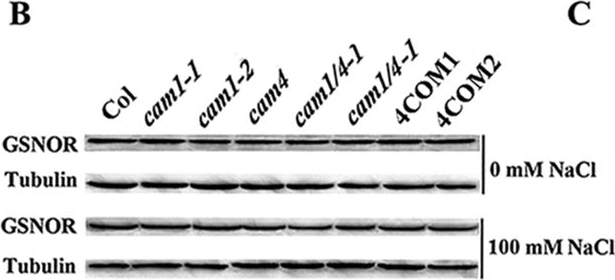
Reactant: Arabidopsis thaliana (Thale cress)
Application: Western Blotting
Pudmed ID: 27684709
Journal: PLoS Genet
Figure Number: 5B
Published Date: 2016-09-01
First Author: Zhou, S., Jia, L., et al.
Impact Factor: 5.334
Open PublicationAtCaM4 decreases GSNOR activity in response to salt stress.(A, E) GSNOR activity of total protein (A) or purified protein (E) from 7-day-old wild-type, cam1-1, cam1-2, cam4, cam1/4-1, cam1/4-2, 4COM1 and 4COM2 seedlings grown in 0.5 × MS medium with or without 100 mM NaCl. The experiments were repeated three times with similar results. Each data point represents the mean ± SD (n = 3). Asterisks indicate a significant difference relative to 0 mM NaCl (Student’s t-test, *P < 0.05 and **P < 0.01). (B) Immunoblot analysis of GSNOR expression in the seedlings. Tubulin was used as an internal control. The experiments were repeated three times; the results indicate similar trends in protein accumulation. (C) SNO content in the seedlings grown in 0.5× MS medium with or without 100 mM NaCl. The experiments were repeated three times with similar results. Each data point represents the mean ± SD (n = 3). The numbers at the top indicate the fold change in SNO level after the salt challenge. (D) GSNOR activity in 7-day-old cam1-1, cam1-2, cam4, cam1/4-1, and cam1/4-2 seedling after addition of 0.1 mM EGTA, 0.02 or 0.04 mM CaM4-GST in the reaction mixture. The experiments were repeated three times with similar results. Each data point represents the mean ± SD (n = 3). Asterisks indicate a significant difference relative to 100 mM NaCl (Student’s t-test, *P < 0.05). (F) Immunoblot analysis of purified GSNOR from total protein with anti-GSNOR. gsnor seedlings was used as a negative control. The experiments were repeated three times; the results indicate similar trends in protein accumulation.
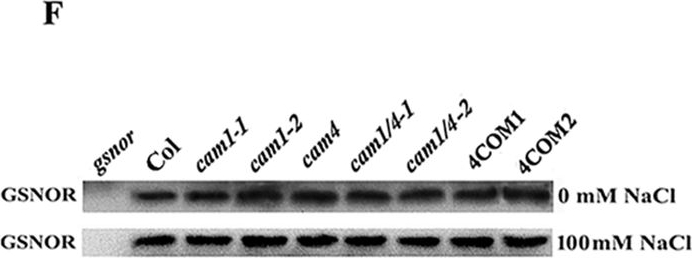
Reactant: Arabidopsis thaliana (Thale cress)
Application: Western Blotting
Pudmed ID: 27684709
Journal: PLoS Genet
Figure Number: 5F
Published Date: 2016-09-01
First Author: Zhou, S., Jia, L., et al.
Impact Factor: 5.334
Open PublicationAtCaM4 decreases GSNOR activity in response to salt stress.(A, E) GSNOR activity of total protein (A) or purified protein (E) from 7-day-old wild-type, cam1-1, cam1-2, cam4, cam1/4-1, cam1/4-2, 4COM1 and 4COM2 seedlings grown in 0.5 × MS medium with or without 100 mM NaCl. The experiments were repeated three times with similar results. Each data point represents the mean ± SD (n = 3). Asterisks indicate a significant difference relative to 0 mM NaCl (Student’s t-test, *P < 0.05 and **P < 0.01). (B) Immunoblot analysis of GSNOR expression in the seedlings. Tubulin was used as an internal control. The experiments were repeated three times; the results indicate similar trends in protein accumulation. (C) SNO content in the seedlings grown in 0.5× MS medium with or without 100 mM NaCl. The experiments were repeated three times with similar results. Each data point represents the mean ± SD (n = 3). The numbers at the top indicate the fold change in SNO level after the salt challenge. (D) GSNOR activity in 7-day-old cam1-1, cam1-2, cam4, cam1/4-1, and cam1/4-2 seedling after addition of 0.1 mM EGTA, 0.02 or 0.04 mM CaM4-GST in the reaction mixture. The experiments were repeated three times with similar results. Each data point represents the mean ± SD (n = 3). Asterisks indicate a significant difference relative to 100 mM NaCl (Student’s t-test, *P < 0.05). (F) Immunoblot analysis of purified GSNOR from total protein with anti-GSNOR. gsnor seedlings was used as a negative control. The experiments were repeated three times; the results indicate similar trends in protein accumulation.
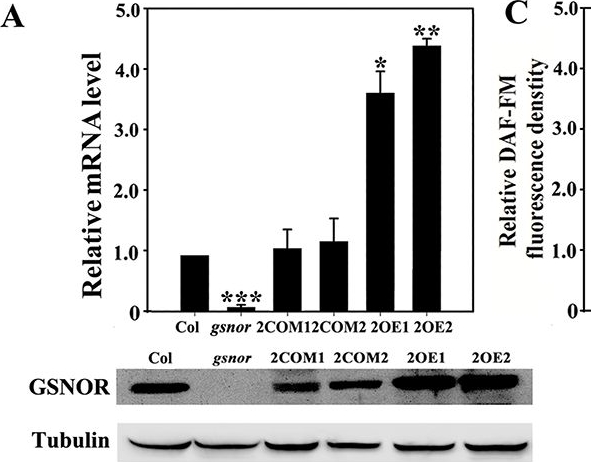
Reactant: Arabidopsis thaliana (Thale cress)
Application: Western Blotting
Pudmed ID: 27684709
Journal: PLoS Genet
Figure Number: 6A
Published Date: 2016-09-01
First Author: Zhou, S., Jia, L., et al.
Impact Factor: 5.334
Open PublicationGSNOR acts as a negative regulator of salt tolerance.(A) RT-qPCR and immunoblot analyses of GSNOR expression in wild-type, gsnor, 2COM1, 2COM2, 2OE1 and 2OE2 plants. The experiments were repeated three times with similar results. Each data point represents the mean ± SD (n = 3). Asterisks indicate a significant difference relative to Col (Student’s t-test, *P < 0.05, **P < 0.01, and ***P < 0.001). (B) NO accumulation in the roots of 7-day-old seedlings. The experiments were repeated three times with similar results. Bar = 50 ?m. (C) Relative DCF fluorescence densities in the roots. Each data point represents the mean ± SE (n = 20). Asterisks indicate a significant difference relative to Col (Student’s t-test, *P < 0.05 and **P < 0.01). (D) Salt stress sensitivity of the seedlings in 0.5× MS medium with or without 100 mM NaCl. The experiments were repeated three times with similar results. (E) Survival ratios of the seedlings after salt treatment. Each data point represents the mean ± SE (n = 30). Asterisks indicate a significant difference relative to Col (Student’s t-test, *P < 0.05 and **P < 0.01). (F) Root lengths of the seedlings with or without 100 mM NaCl. Each data point represents the mean ± SE (n = 30). The numbers at the top indicate the fold change in root length after the salt challenge.
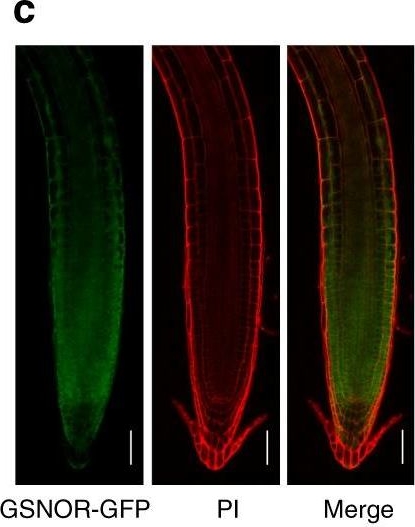
Reactant: Arabidopsis thaliana (Thale cress)
Application: Immunocytochemistry-immunoflourescence
Pudmed ID: 31467270
Journal: Nat Commun
Figure Number: 6C
Published Date: 2019-08-29
First Author: Li, B., Sun, L., et al.
Impact Factor: 13.783
Open PublicationGSNOR alleviates Fe-dependent NO and H2O2 toxicities to promote root meristem growth. a Box plots for root growth upon high Fe and nitric oxide (NO) donor (sodium nitroprusside, SNP) at day 7 (n?=?16 biologically independent samples). Root length of hot5-2 relative to WT is shown in the right panel. b Fluorescence signal of root NO stained with DAF-FM at day 6. White arrows denote cortex cells in meristems. c Fluorescence signal of root expressing pGSNOR:GSNOR-GFP at day 6 under control conditions. d Root meristems stained by propidium iodide (PI) at day 6. e Box plots for root meristem of experiments depicted in (d) (n?=?10 biologically independent samples). f Root meristems stained by PI upon H2O2 and Fe treatments at 7 days. White arrows indicate the border of elongation zone, while region outlined in white line and asterisk indicates cell death in the root meristem (d, f). g Box plots for root meristem length of experiments depicted in (f) (n?=?9 biologically independent samples). Different letters indicate the significant differences according to Tukey’s HSD test (p?
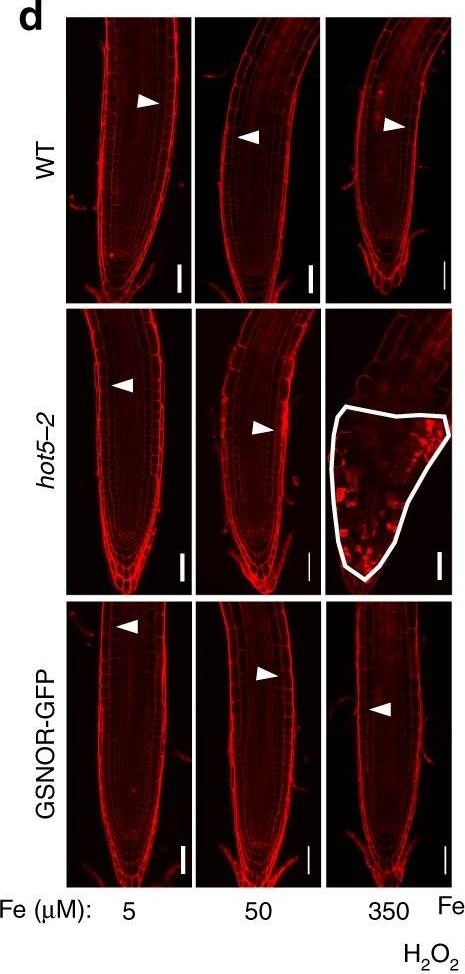
Reactant: Arabidopsis thaliana (Thale cress)
Application: Immunocytochemistry-immunoflourescence
Pudmed ID: 31467270
Journal: Nat Commun
Figure Number: 6D
Published Date: 2019-08-29
First Author: Li, B., Sun, L., et al.
Impact Factor: 13.783
Open PublicationGSNOR alleviates Fe-dependent NO and H2O2 toxicities to promote root meristem growth. a Box plots for root growth upon high Fe and nitric oxide (NO) donor (sodium nitroprusside, SNP) at day 7 (n?=?16 biologically independent samples). Root length of hot5-2 relative to WT is shown in the right panel. b Fluorescence signal of root NO stained with DAF-FM at day 6. White arrows denote cortex cells in meristems. c Fluorescence signal of root expressing pGSNOR:GSNOR-GFP at day 6 under control conditions. d Root meristems stained by propidium iodide (PI) at day 6. e Box plots for root meristem of experiments depicted in (d) (n?=?10 biologically independent samples). f Root meristems stained by PI upon H2O2 and Fe treatments at 7 days. White arrows indicate the border of elongation zone, while region outlined in white line and asterisk indicates cell death in the root meristem (d, f). g Box plots for root meristem length of experiments depicted in (f) (n?=?9 biologically independent samples). Different letters indicate the significant differences according to Tukey’s HSD test (p?
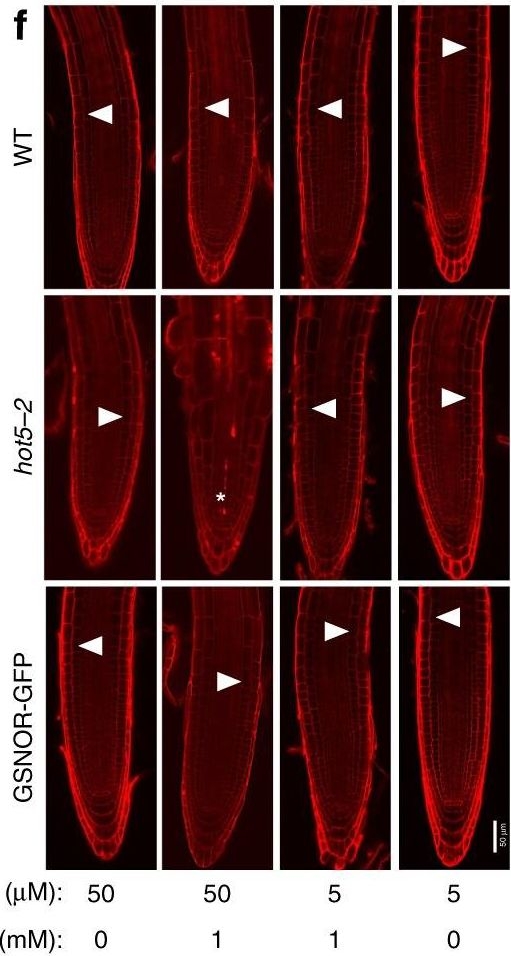
Reactant: Arabidopsis thaliana (Thale cress)
Application: Immunocytochemistry-immunoflourescence
Pudmed ID: 31467270
Journal: Nat Commun
Figure Number: 6F
Published Date: 2019-08-29
First Author: Li, B., Sun, L., et al.
Impact Factor: 13.783
Open PublicationGSNOR alleviates Fe-dependent NO and H2O2 toxicities to promote root meristem growth. a Box plots for root growth upon high Fe and nitric oxide (NO) donor (sodium nitroprusside, SNP) at day 7 (n?=?16 biologically independent samples). Root length of hot5-2 relative to WT is shown in the right panel. b Fluorescence signal of root NO stained with DAF-FM at day 6. White arrows denote cortex cells in meristems. c Fluorescence signal of root expressing pGSNOR:GSNOR-GFP at day 6 under control conditions. d Root meristems stained by propidium iodide (PI) at day 6. e Box plots for root meristem of experiments depicted in (d) (n?=?10 biologically independent samples). f Root meristems stained by PI upon H2O2 and Fe treatments at 7 days. White arrows indicate the border of elongation zone, while region outlined in white line and asterisk indicates cell death in the root meristem (d, f). g Box plots for root meristem length of experiments depicted in (f) (n?=?9 biologically independent samples). Different letters indicate the significant differences according to Tukey’s HSD test (p?<?0.05) between genotypes or different conditions in a given genotype. nd denotes not detected. Scale bar: 20?µm in (b); 50?µm in (c, d and f). The Source data of Fig. 6a, e, and g are provided in a Source Data file
- Additional Information
-
Additional information: Antibody is easily detecting GSNOR in a load per well of 5 µg of total Arabidopsis thaliana cell extract
- Background
-
Background: S-nitrosoglutathione reductase (GSNOR) is a cytoplasm localized enzyme which plays a key role in formaldehyde detoxification and is down regulated by wounding and activated by salicylic acid (SA).
Alternative protein names: Alcohol dehydrogenase class-3, Alcohol dehydrogenase class-III, FALDH, FDH formaldehyde dehydrogenase, alcohol dehydrogenase III, HOT5, S-(hydroxymethyl)glutathione dehydrogenase, Glutathione-dependent formaldehyde dehydrogenase, GSH-FDH - Product Citations
-
Selected references: Oláh et al. (2023). Suboptimal zinc supply affects the S-nitrosoglutathione reductase enzyme and nitric oxide signaling in Arabidopsis. Plant Stress Volume 10, December 2023, 100250.
Kolbert et al. (2023). Nitro-oxidative response to internalized multi-walled carbon nanotubes in Brassica napus and Solanum lycopersicum. Ecotoxicol Environ Saf. 2023 Nov 15:267:115633. doi: 10.1016/j.ecoenv.2023.115633.
Molnar et al. (2022) Limited Zn supply affects nutrient distribution, carbon metabolism and causes nitro-oxidative stress in sensitive Brassica napus, Environmental and Experimental Botany,Volume 202, 2022, 105032,ISSN 0098-8472,https://doi.org/10.1016/j.envexpbot.2022.105032.
Zhang et al (2021) Induction of S-nitrosoglutathione reductase protects root growth from ammonium toxicity by regulating potassium homeostasis in Arabidopsis and rice. J Exp Bot. 2021 Mar 27:erab140. doi: 10.1093/jxb/erab140. Epub ahead of print. PMID: 33772588.
Borbély et al. (2021) The Effect of Foliar Selenium (Se) Treatment on Growth, Photosynthesis, and Oxidative-Nitrosative Signalling of Stevia rebaudiana Leaves. Antioxidants (Basel). Jan 8;10(1):E72. doi: 10.3390/antiox10010072. PMID: 33429850.
Labudda et al. (2020). Cyst Nematode Infection Elicits Alteration in the Level of Reactive Nitrogen Species, Protein S-Nitrosylation and Nitration, and Nitrosoglutathione Reductase in Arabidopsis thaliana. Antioxidants (Basel) . 2020 Aug 26;9(9):E795.doi: 10.3390/antiox9090795.
Molnár et al. (2020). Nitro-oxidative Signalling Induced by Chemically Synthetized Zinc Oxide Nanoparticles (ZnO NPs) in Brassica Species. Chemosphere, 251, 126419
Zhang et al. (2020). Glutathione-dependent denitrosation of GSNOR1 promotes oxidative signaling downstream of H2 O2. Plant Cell Environ. 2020 Jan 28. doi: 10.1111/pce.13727.
Zhang et al. (2019). Arabidopsis CaM3 inhibits nitric oxide accumulation and improves thermotolerance by promoting S-nitrosoglutathione reductase via direct binding. Plant Growth Regul 90, 41–50.
Feigl et al. (2019). Zinc-induced root architectural changes of rhizotron-grown B. napus correlate with a differential nitro-oxidative response. Nitric Oxide. 2019 Sep 1;90:55-65. doi: 10.1016/j.niox.2019.06.003.
Jain et al. (2018). S-nitrosylation/denitrosylation as a regulatory mechanism of salt stress sensing in sunflower seedlings. Physiol Plant. 2018 Jan;162(1):49-72. doi: 10.1111/ppl.12641.
Kovacs et al. (2016). ROS-Mediated Inhibition of S-nitrosoglutathione Reductase Contributes to the Activation of Anti-oxidative Mechanisms.Front. Plant Sci., 10 November 2016
McLoughlin et al. (2016) Class I and II Small Heat Shock Proteins Together with HSP101 Protect Protein Translation Factors during Heat Stress. Plant Physiol. 2016 Oct;172(2):1221-1236.
Zhou et al. (2016). Arabidopsis CaM1 and CaM4 Promote Nitric Oxide Production and Salt Resistance by Inhibiting S-Nitrosoglutathione Reductase via Direct Binding. PLoS Genet. 2016 Sep 29;12(9):e1006255. doi: 10.1371/journal.pgen.1006255. eCollection 2016.
Lee et al. (2008). Modulation of nitrosative stress by S-nitrosoglutathione reductase is critical for thermotolerance and plant growth in Arabidopsis. The Plant Cell 20: 786-802. - Protocols
-
Agrisera Western Blot protocol and video tutorials
Protocols to work with plant and algal protein extracts
Agrisera Educational Posters Collection
- Reviews:
-
This product doesn't have any reviews.



